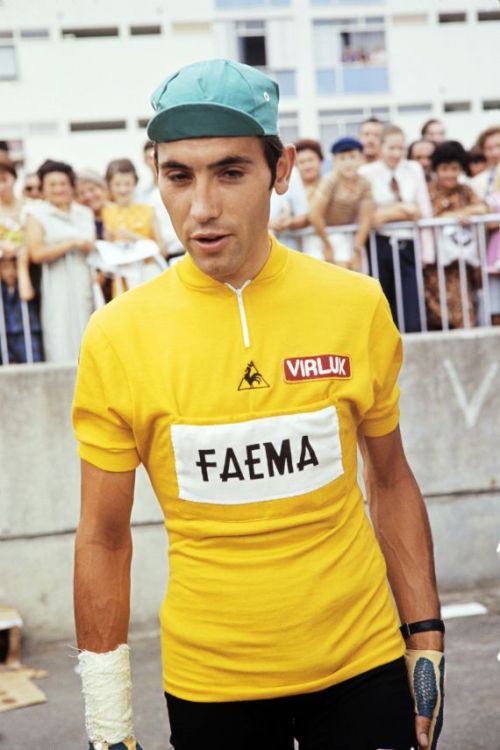Eddy Merckx, born in June 17,
1945, rode for thirteen seasons, but thoroughly dominated cycling
for a full ten years like no one else has before or since. Winning the Amateur World Championship Road Race in 1964 he turned pro in
1965.
His first major victory came in the 1966 Milan-San Remo at
age 20. His last major victory was in that same race, ten years later.
In his peak years, 1969 through 1975, Merckx won an astounding 35% of
races entered.
He won the Tour de France and the Giro d´Ítalia five times and the Vuelta a Espana once.
He won each of cycling’s five monuments
(Milan-San Remo, Tour of Flanders, Paris-Roubaix, Liege-Bastogne-Liege,
Tour of Lombardy) more than twice, for a record of nineteen victories in
these races.
Between 1968 and
1974, he eleven Grand Tours. He is the only rider to win
all of the classifications (overall, mountains and points jerseys) in a
single year at the Tour de France (1969) and the Giro d’Italia (1968). Additionlly he achieved an hour world record in Oktober 1972 (with 49,431 km/h) that was unbeaten for at least 42 years. Awesome.
Formerly the the Tour de France started with trade teams only, switched to national teams in 1930, moved to trade teams in 1962 and decided baed on the riders strike near Bordeaux in 1966 to return to national teams again.
When 1969 tour was pronounced to return to trade teams Eddy Merckx joined the Faema Team and won the general classification (yellow jersey), points classification (green jersey) and the mountains classification and became. As he was the fist time Belgian who won the Tour since Sylvère Maes 30 years earlier he became a national hero as well.
In 1971 he switched to the Molteni Team and intruduced his own racing frames to the equipe Molteni
Within his active carrer Eddy Merckx rode frames from Masi, Colnago, Kessels and De Rosa. Since Ernesto Colnago sponsored the Molteni Team during the periode of 1968 to 1973 the switch to frames made by Kessels must have been done in 1974.
Kessels was a Belgian framebuilder who had a quite reasonably sized
frame shop in Ostend building both top race bikes and cheaper
look-a-likes.
This frame with Campagnolo dropouts and the two large
round cutouts in the bottom bracket shell is supposed to be an
ex-team bike, shows its original paint and decals and many signs of being
much raced and well-used within the team/ equipe. The bottom bracket shows hadnwritten with white enamel the name of the original driver.
Bottom Braket: Campagnolo Nuovo Record
Headset: Campagnolo Nuovo Record
Crankset: Campagnolo Nuovo Record
Front Derailleur: Campagnolo Nuovo Record
Rear Derailleur: Campagnolo Nuovo Record
Shift levers: Campagnolo Nuovo Record
Brake Lever: Campagnolo Nuovo Record
Brakes: Campagnolo Nuovo Record
Wheelset: Campagnolo Nuovo Record with Mavic tubular rims
Saddle: Brooks Professional
Seatpost: Campagnolo Nuovo Record
Stem: Ambrosio/ 3ttt Record
Handlebar: 3ttt
Pedals: Gipiemme Pista
Frame tubing: Reynolds 531
Fork tubing: Reynolds 531




















































